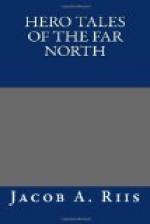In the Dean’s employ his organizing genius developed the marvellous skill of the cataloguer that brought order out of the chaos of groping and guessing and blundering in which the science of botany had floundered up till then. Here and there in it all were flashes of the truth, which Linnaeus laid hold of and pinned down with his own knowledge to system and order. Thus the Frenchman, Sebastian Vaillant, who had died a dozen years before, had suggested a classification of flowers by their seed-bearing organs, the stamens and pistils, instead of by their fruits, the number of their petals, or even by their color, as had been the vague practice of the past. Linnaeus seized upon this as the truer way and wrote a brief treatise developing the idea, which so pleased Dr. Celsius that he got his young friend a license to lecture publicly in the Botanical Garden.
The students flocked to hear him. His message was one that put life and soul into the dry bones of a science that had only wearied them before. The professor of botany himself sat in the front row and hammered the floor with his cane in approval. But his very success was the lecturer’s undoing. Envy grew in place of the poverty he had conquered. The instructor, Nils Rosen, was abroad taking his doctor’s degree. He came home to find his lectures deserted for the irresponsible teachings of a mere undergraduate. He made grievous complaint, and Linnaeus was silenced, to his great good luck. For so his friend the professor, though he was unable to break the red tape of the university, got him an appointment to go to Lapland on a botanical mission. His enemies were only too glad to see him go.
Linnaeus travelled more than three thousand miles that summer through a largely unknown country, enduring, he tells us, more hardships and dangers than in all his subsequent travels. Again and again he nearly lost his life in swollen mountain streams, for he would not wait until danger from the spring freshets was over. Once he was shot at as he was gathering plants on a hillside, but happily the Finn who did it was not a good marksman. Fish and reindeer milk were his food, a pestilent plague of flies his worst trouble. But, he says in his account of the trip, which is as fascinating a report of a scientific expedition as was ever penned, they were good for something, after all, for the migrating birds fed on them. From his camps on lake or river bank he saw the water covered far and near with swarms of ducks and geese. The Laplander’s larder was easily stocked.
He came back from the dangers of the wild with a reputation that was clinched by his book “The Flora of Lapland,” to find the dragon of professional jealousy rampant still at Upsala. His enemy, Rosen, persuaded the senate of the university to adopt a rule that no un-degreed man should lecture there to the prejudice of the regularly appointed instructors. Tradition has it that Linnaeus flew into a passion




